BRP Lawsuit against Arctic Cat Ends 2011 with a Bang
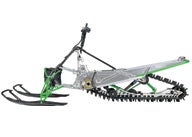
A look at happenings in the business of snowmobiling in 2011
As we prepare to leave good old snowy 2011 for soon to snow (?) 2012, we have some opinions to share about bits of news that have come up in the past few weeks. As we have noted numerous times before, the snowmobile industry, while on a rebound by comparison to previous seasons, remains a shadow of what was once projected to be a one-million unit per year business.
Of course, what did those 1970 Wall Street experts know about a future that would see freaky low snow seasons, severely fluctuating economics and troubles with the worldwide oil supply? So, from a projected annual million units, snowmobile firms sold 495,000 units in 1971. By 1992 sales were down to 150,000. Then we saw a steady rise in unit sales as snow seasons settled into a fairly consistent pattern and the economic outlook seemed to solidify. In a short six years, sled sales hit nearly 261,000 units. Of course, that was a highlight as we entered some really tough times that made the 1970s seem easy-breezy. At the end of 2011, which proved to be a very good snow year, the snowmobile manufacturers’ association claims that sales hit a recent high near 125,000 units. Even if you are not an economics major — and we most certainly were not! — you can readily see that those numbers are low by 1992 standards. It also explains why each and every snowmobile sale is seriously contested by today’s snowmobile manufacturers.
Just look out West, where mountain sleds have been the single most consistent sales region in the snowmobile business. Even though local riders may complain of “poor” snow in the recent past, the fact remains that the mountain riding areas had snow! And snow means sled sales. The battle for sales is serious. Arctic Cat held a strong market share, but as the company worked on its 2012 models that market fell to Polaris, which had developed its very popular powder-special models. Still, in Polaris’ Year Two of powder sales growth, both Arctic Cat and Ski-Doo have devoted ample resources to win back a share of deep snow runners.
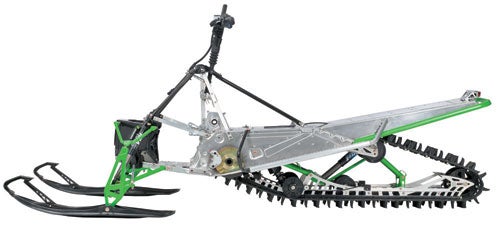 Will a court have to determine how closely, if at all, the 2012 Arctic Cat Procross chassis resembles Ski-Doo’s REV platform?
Will a court have to determine how closely, if at all, the 2012 Arctic Cat Procross chassis resembles Ski-Doo’s REV platform?With all that said, you can figure that no sled maker willingly will give up sales without a fight. On December 15th, that fight became very serious as Bombardier Recreational Products Inc and BRP US Inc, filed suit and a demand for jury trail for patent infringement against Arctic Cat, Inc. This suit, filed in US District Court for the Northern District of Illinois, alleges, “…Arctic Cat has infringed various Canadian and American patents for the revolutionary REV platform used in BRP’s lines of snowmobiles.”
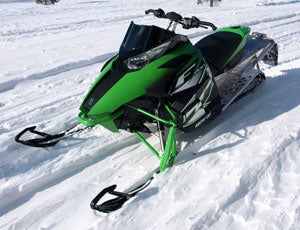 Arctic Cat’s all-new F 800 Sno Pro was named specifically as infringing on Ski-Doo patents.
Arctic Cat’s all-new F 800 Sno Pro was named specifically as infringing on Ski-Doo patents.Basically, the two companies are at odds over Arctic Cat’s newest Procross chassis construction, which BRP claims infringes on its US Patent 7,124,847 (among others). Entitled “Frame Construction for a Vehicle,” that patent is referred to in the court documents as simply “the ‘847” patent. Basically BRP claims that Arctic Cat’s new sled design, specifically the 2012 model year F 800 Sno Pro is too closely related to the existing REV platform that has given Ski-Doo its core sales strength since it was introduced back in 2002.
According to a release from BRP, the company filed court documents asserting that Arctic Cat knowingly used certain innovations protected by BRP’s patents, without permission. The cruncher for Arctic Cat comes from BRP’s request that Arctic Cat halt production of the infringing models and that it destroy those in stock. Plus, BRP is seeking monetary compensation for the infringement.
Representing BRP, Martin Langelier, vice-president, General Counsel and Secretary said: “In recent years we have seen our competitors attempt to copy an increasing number of our inventions and designs. …Innovation being at the core of BRP’s strategy, we will not tolerate infringement of our intellectual property rights. We are, as a result, taking legal action to protect them.”
When the REV design was introduced in 2002, BRP and Ski-Doo claim that it revolutionized the snowmobile industry, allowing the Ski-Doo brand to regain the number one position in the industry, a lead it has since maintained.
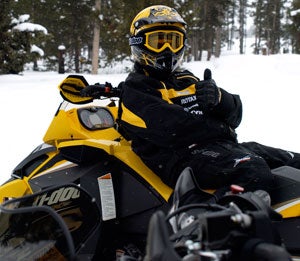 Ski-Doo’s REV brought the rider forward and centered the engine mass for a lightweight handling sled.
Ski-Doo’s REV brought the rider forward and centered the engine mass for a lightweight handling sled.While we are certainly not lawyers, we have seen snowmobile companies battling each other in court before. In fact, in 2003 Arctic Cat dropped a lawsuit it filed against Polaris, alleging infringement of Arctic Cat’s exhaust temperature ignition timing patent on high-performance engines used chiefly for snowmobile racing. Arctic Cat dismissed the suit after Polaris discontinued using it in racing snowmobiles.
At the time, then Arctic Cat CEO Chris Twomey was quoted as saying: “We sued Polaris to prevent it from selling racing snowmobiles that infringed our patent. Our pioneering technology provides a competitive advantage to our snowmobile racers. During the course of the litigation, Polaris revealed that it had stopped using Arctic Cat’s patented technology in its racing snowmobiles. We conclude that Polaris stopped because the company knew it had infringed our patent. We achieved our goal, so we dismissed the lawsuit.”
Since Ski-Doo introduced the REV with its rider-forward design, other snowmobile manufacturers have come to market with their own versions of a rider forward positioning. Arctic Cat’s pre-2012 model year sleds also offered a version of ride-forward that included multi-adjustable handlebars, seat and foot positioning.
In many cases snowmobile companies “share” technology under some form of a licensing agreement. That has been the case with the electronic reverse system that Ski-Doo pioneered and is now used by both Polaris and Arctic Cat in their two-stroke drive trains.
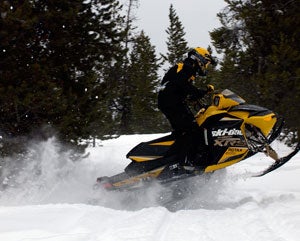 The REV chassis has helped Ski-Doo climb to Number 1 in sled sales.
The REV chassis has helped Ski-Doo climb to Number 1 in sled sales.Of course, that does not pose the seriousness of this court filing. Should, for example, BRP file a cease and desist order to stop Arctic Cat from selling its 2012 model year sleds, it could cripple Arctic Cat sales. And how about sleds that have been sold already? Would they have to be recalled for destruction?
This is interesting timing and more information will most likely come out as the sides prepare their cases. But why is this suit coming out now? The new 2012 Arctic Cat design is no secret; it has been public knowledge since March.
Of course, it wasn’t until this autumn that any one truly knew how popular the 2012 series has been. We’ve heard that Arctic Cat virtually sold out of product to its dealers. And we have had dealers tell us that they could sell all the turbo-powered versions that they could their hands on. Heck, one dealer has told us that he can’t get any more turbo Cats and that consumers simply can’t find them around.
The latest Arctic Cat Procross chassis snowmobiles rated extremely well with our test crew and have proven popular with Arctic Cat enthusiasts, who have been waiting for an exciting new breed to come along since Cat discontinued the Firecat series.
Looks like the latest battle for sled sales has taken a turn for the courts. Stay tuned on this as we wait to see what this court filing produces. From what we’re reading, this is a serious matter for both companies involved. And it definitely does affect us as snowmobilers.
Yamaha Bravo Fades
While the BRP versus Arctic Cat lawsuit is the big end of the year news, we must comment on the passing of a fading snowmobile, the Yamaha Bravo. Honestly, this was never one of favorites, but we were never its target audience.
The Bravo was an honest sled, in the vein of Ski-Doo’s old Elan. Although U.S. Yamaha dealers stopped selling the little single cylinder sled a number of years ago, other markets have finally discontinued it, with Canada being the last holdout.
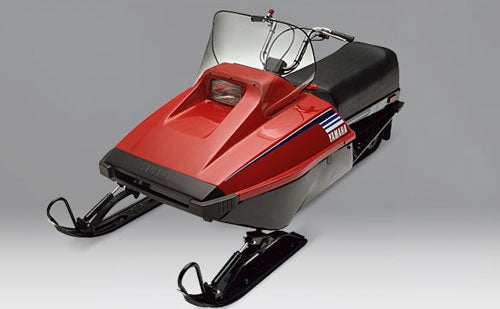 Due to its compact engine and incredibly light frame, the Bravo set the standard for lightweight machines.
Due to its compact engine and incredibly light frame, the Bravo set the standard for lightweight machines.The Bravo served as a replacement for Yamaha’s popular Enticer 250 and over its life cycle was equipped with three different length tracks ranging from the standard 96-inch long one up to a 136-inch length. It came in a basic “sport” style with short wheelbase or was once even outfitted in the Trapper format. This version came with rack and long track.
Yamaha engineers worked to keep costs down on this sled to the extent that its 250cc two-cycle engine featured a one-piece cylinder and head to simplify its engineering. In addition Bravo’s motor mount used the same 4 bolts to hold the base plate and the case halves together. The one-piece air-box and steering gate did double duty by holding the steering column and electrical connector blocks as well as the air-intake.
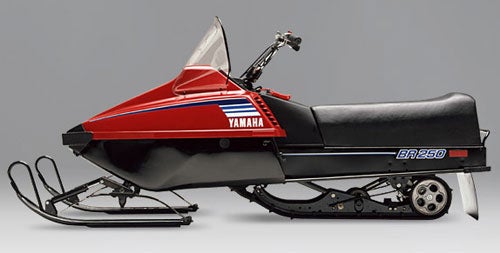 Yamaha’s first BR250 was a hit with everyone from beginners to veterans.
Yamaha’s first BR250 was a hit with everyone from beginners to veterans.Yamaha Canada lists the Bravo as its best seller, ever. Of course, the sled was around since 1981 and was popular with many snowmobilers for its simplicity of design, incredible versatility and its low buck pricing. Since the Bravo frequented back country areas and needed fuel range, its major “upgrade” came when Yamaha engineers added a gallon more fuel capacity in the storage box area.
While there will be an existing demand for the Bravo in back country areas, the two-stroke was an anachronism that also suffered from worn out tooling that would cost way too much to remanufacture. And, of course, getting the two-stroke single up to meet planned EPA emissions would be cost-prohibitive. So, sorry, Bravo, the end is here. If you want an instant classic, get your hands on a Yamaha Bravo.
Related Reading BRP files lawsuit against Arctic Cat 2012 Arctic Cat ProCross F800 LXR Review 2012 Ski-Doo MX Z X-RS 800 Review [Video] 2012 Ski-Doo MXZ TNT 600 E-TEC Review 2011 Ski-Doo MXZ TNT 800R E-TEC Review








 Your Privacy Choices
Your Privacy Choices